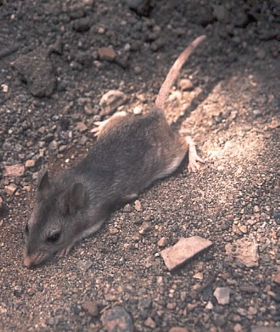Southern grasshopper mouse facts for kids
Quick facts for kids Southern grasshopper mouse |
|
|---|---|
 |
|
| Conservation status | |
| Scientific classification | |
| Genus: |
Onychomys
|
| Species: |
torridus
|
The southern grasshopper mouse or scorpion mouse (Onychomys torridus) is a small, fierce rodent. It belongs to the mouse family, Cricetidae. You can find it in Mexico and parts of the United States. These states include Arizona, California, Nevada, New Mexico, and Utah. This mouse is famous for being able to hunt and eat the very poisonous Arizona bark scorpion. It does this without getting hurt by the scorpion's sting!
Contents
Meet the Southern Grasshopper Mouse
The southern grasshopper mouse is a strong, small mouse. It hunts mostly at night. These mice often live in pairs. They have a short tail. Their total length is about 12 to 16 centimeters (about 5 to 6.5 inches).
Their fur is pinkish-brown or grayish-brown on their head, back, and sides. Their belly is white. There is a clear line where the two colors meet. Their tail is short and thick, like a club. The part near their body is the same color as their fur, but the tip is white.
What Do Grasshopper Mice Eat?
Southern grasshopper mice mostly eat arthropods. These are creatures like beetles, grasshoppers, and scorpions. They also hunt other small rodents. These can include the little pocket mouse and the western harvest mouse.
How They Handle Scorpion Stings
In the hot, dry places where these mice live, the Arizona bark scorpion is very common. Most animals avoid this scorpion because its sting is very painful. But the grasshopper mouse can eat these scorpions even if it gets stung many times in the face.
Scientists have found out how they do this. The scorpion's venom usually causes pain. But in the mouse, the venom actually blocks pain signals from reaching its brain. The mouse might feel a quick sting at first. But then the venom acts like a temporary pain reliever. It stops the pain messages. This means the mouse can keep eating the scorpion without feeling much pain.
Life Cycle and Reproduction
Female grasshopper mice can have several litters of babies in one year. However, they usually only have babies during their first year of life. On average, a mother mouse has about 2 or 3 babies in each litter. She carries her babies for about 29 days before they are born.
When the babies are born, they are naked and pink. After one day, their skin starts to get darker on their back. By day ten, they have short hairs growing on their back. Their eyes open when they are about 15 days old. They start eating solid food around day 19. Female mice usually have their first litter when they are four or five months old.
Where Grasshopper Mice Live
Southern grasshopper mice are special among North American rodents. This is because they mostly eat insects and other arthropods. They usually live in areas where there are not many other mice. Studies show that they naturally have smaller populations. This is partly because females are only active in breeding for one season. Males also have breaks in their breeding activity.
These mice live in hot, dry valleys and scrub deserts. A male and female mouse, along with their babies, use a larger area for their burrows. Males usually have a home range of about 7.8 acres. Females use a smaller area, about 5.9 acres. They tend to stay in one place for a longer time than other mammals. Their home ranges are not too far apart. Adult males can be very protective of their space. They make loud calls at night to warn other mice to stay away.
Hunting Habits
Southern grasshopper mice are very aggressive hunters. In one study, scientists observed these mice when they were hungry. They saw how the mice hunted crickets and even other lab mice. After two days without food, the grasshopper mice spent more time eating crickets than their regular lab food. They liked live crickets more than dead ones. This suggests that movement helps them decide to attack.
The mice also showed very aggressive behavior towards lab mice. They would bite the back and tail of their prey. After two days of being with the lab mice, some of the grasshopper mice killed and ate parts of them. This study showed that being hungry and the type of prey affected how aggressive the grasshopper mice were when hunting.
Brain and Body Size
The size of an animal's brain can be related to what it eats. Animals that eat only plants usually have the smallest brains. Those that eat seeds or insects have larger brains. Animals that eat many different things have the largest brains.
Scientists have measured the brains of southern grasshopper mice. On average, females were heavier and longer than males. But their brain size was slightly smaller than males. This difference was not very big. This pattern of brain and body size is also seen in northern grasshopper mice. The tail of a southern grasshopper mouse is about one-third of its body length.
Female southern grasshopper mice can have a larger body size without needing a bigger brain compared to males. Scientists are still trying to understand why this is. It might be because males and females have different needs in their lives. These studies were done in labs. There might be other stresses in their natural home that affect brain growth.


